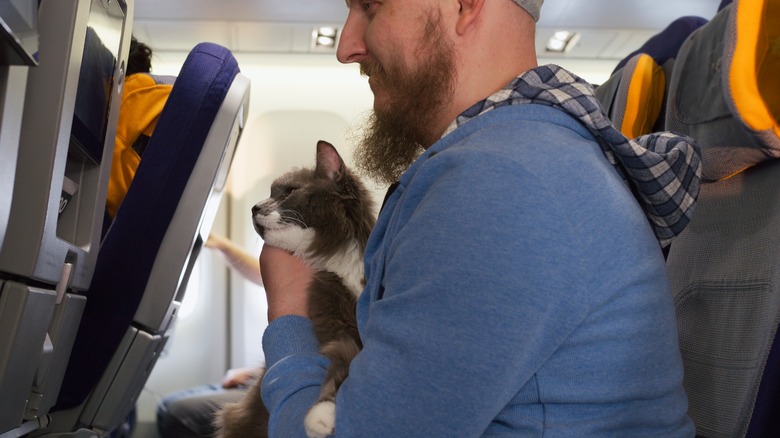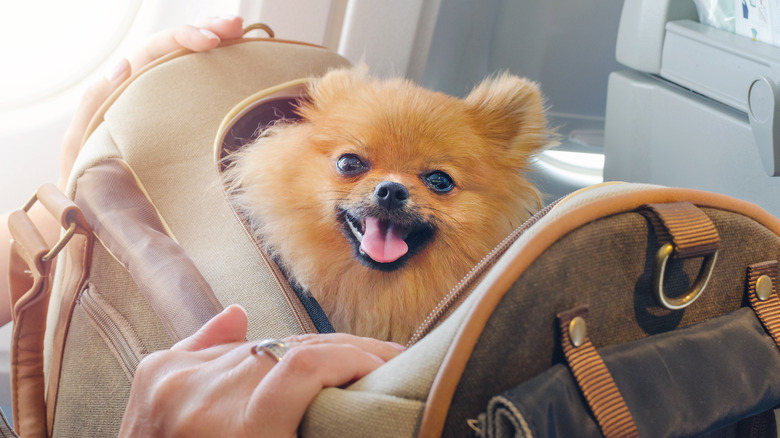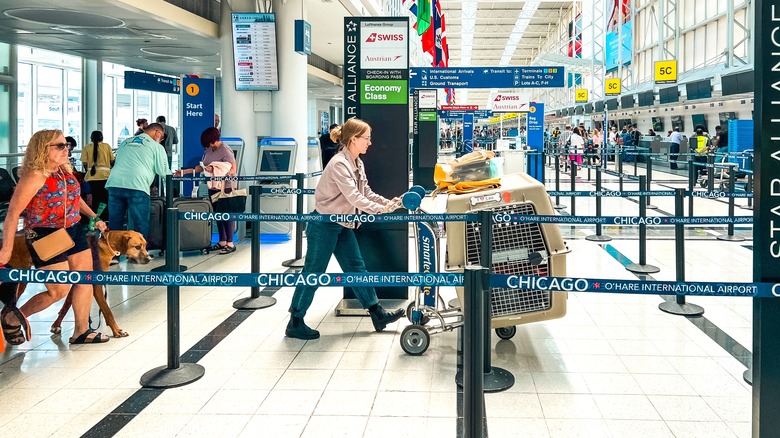Can You Purchase Your Dog Or Cat A Seat On The Plane?
Traveling with your pet isn't always an easy feat, especially if you plan on flying to your destination. Besides preparing all the necessary paperwork and packing your furry friend's essential items, you'll also have to book their spot on the plane. And, in most cases, this won't be a cozy seat next to you in the cabin.
Most airlines don't allow pet owners to purchase a seat for Fido or Fluffy, no matter how clean and well-behaved the animal is. However, there are a few notable exceptions that you may be able to book for your next vacation. For instance, JetBlue and Alaska Airlines allow seat reservations for pets, but the dog or cat must remain in their carrier throughout the flight and should be placed under the seat during take-off and landing. Internationally, Etihad Airways and Belarus' Belavia also permit pets on seats next to their owners. Alternatively, you can also research private and special charter companies in your area, such as BarkAir, that are geared toward pet owners.
Additionally, service dogs may — in some cases — also have access to extra space. Depending on the animal's size, service pets are usually allowed on the passenger's lap or the floor. However, because the dog can't block the aisle, cabin attendants may seat the owner and their pet in a row with two or more empty seats. Note that airlines aren't required to offer these accommodations.
Where can pets sit in the plane cabin?
Unless you've booked a flight with one of the few airlines that allow seats for pets, your fur baby will usually have to stay put under the seat in front of you. For this reason, many airlines don't allow passengers traveling with pets to book bulkhead seats and business class spots, as these rows don't have a space on the floor to place the animal securely. The dog or cat also shouldn't be placed anywhere that could obstruct other passengers during an emergency, including the exit aisles.
These requirements also mean your pet must be small enough to fit under the seat comfortably. Most airlines list required carrier dimensions on their website, and some explicitly state that the animal must be able to stand up and turn around in the bag. These rules usually apply even if you secured an extra seat for your canine or feline friend. If your pet is too large for their carrier, they may be barred from boarding or even placed on the dreaded no-fly list for dogs.
Larger dogs are usually limited to the cargo hold
Remember that pets are usually required to be kept in a carrier, even if there's a seat designated for them on your flight. With this requirement in mind, large dogs and many medium-sized dogs won't be allowed to travel with you in the cabin, unless they're a service animal. Instead, you'll have to fly your pet in a cargo hold or baggage storage compartment on the plane.
Separating from your furry friend during the flight can be nerve-wracking, but there are steps you can take to make the journey as comfortable as possible for your pet. First, choose a sturdy, hard-side crate large enough for your pet to move around. Make sure it protects your pooch while offering sufficient ventilation. If your dog isn't used to being in a crate, practice at home before your trip. Line the bottom of the crate with absorbent pads, and attach a bowl with water (freeze the water so it can gradually melt) before your flight.
Note that some airlines no longer allow large dogs to fly in the cargo hold. In the U.S., only a few carriers, including Alaska Airlines, American Airlines, and Hawaiian Airlines, permit pets in the baggage or cargo compartment. Check with your airline first to ensure your large pet is allowed on board before booking your tickets.


